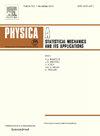Assortativity in sympatric speciation and species classification
IF 2.8
3区 物理与天体物理
Q2 PHYSICS, MULTIDISCIPLINARY
Physica A: Statistical Mechanics and its Applications
Pub Date : 2024-09-19
DOI:10.1016/j.physa.2024.130111
引用次数: 0
Abstract
We investigate the role of assortative mating in speciation using the sympatric model of Derrida and Higgs. The model explores the idea that genetic differences create incompatibilities between individuals, preventing mating if the number of such differences is too large. Speciation, however, only happens in this mating system if the number of genes is large. Here we show that speciation with small genome sizes can occur if assortative mating is introduced. In our model individuals are represented by three chromosomes: one responsible for reproductive compatibility, one for coding the trait on which assortativity will operate, and a neutral chromosome. Reproduction is possible if individuals are genetically similar with respect to the first chromosome, but among these compatible mating partners, the one with the most similar trait coded by the second chromosome is selected. We show that this type of assortativity facilitates speciation, which can happen with a small number of genes in the first chromosome. Species, classified according to reproductive isolation, dictated by the first chromosome, can display different traits values, as measured by the second and the third chromosomes. Therefore, species can also be identified based on similarity of the neutral trait, which works as a proxy for reproductive isolation.
同域物种变异和物种分类中的同源性
我们利用德里达(Derrida)和希格斯(Higgs)的同种交配模型研究了同种交配在物种分化中的作用。该模型探讨的观点是,基因差异会造成个体间的不相容性,如果这种差异数量过大,就会阻碍交配。然而,在这种交配系统中,只有当基因数量很大时,物种才会发生分化。在这里,我们证明,如果引入同配交配,基因组规模较小的物种也会出现。在我们的模型中,个体由三条染色体代表:一条负责生殖兼容性,一条负责编码同配性状,还有一条中性染色体。如果个体与第一条染色体的基因相似,那么就可以进行繁殖,但在这些相容的交配对象中,由第二条染色体编码的性状最相似的个体会被选中。我们的研究表明,这种类型的同配性有利于物种的形成,而第一条染色体上的基因数量较少就能实现物种的形成。根据第一条染色体所决定的生殖隔离进行分类的物种,可以显示出第二和第三条染色体所衡量的不同性状值。因此,也可以根据中性性状的相似性来识别物种,中性性状可以作为生殖隔离的替代物。
本文章由计算机程序翻译,如有差异,请以英文原文为准。
求助全文
约1分钟内获得全文
求助全文
来源期刊
CiteScore
7.20
自引率
9.10%
发文量
852
审稿时长
6.6 months
期刊介绍:
Physica A: Statistical Mechanics and its Applications
Recognized by the European Physical Society
Physica A publishes research in the field of statistical mechanics and its applications.
Statistical mechanics sets out to explain the behaviour of macroscopic systems by studying the statistical properties of their microscopic constituents.
Applications of the techniques of statistical mechanics are widespread, and include: applications to physical systems such as solids, liquids and gases; applications to chemical and biological systems (colloids, interfaces, complex fluids, polymers and biopolymers, cell physics); and other interdisciplinary applications to for instance biological, economical and sociological systems.

 求助内容:
求助内容: 应助结果提醒方式:
应助结果提醒方式:


